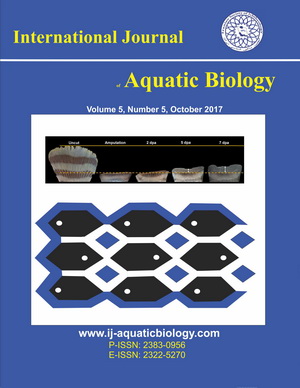Green mussel (Perna viridis) culture in recirculating aquaculture system: A performance evaluation from Cox's Bazar, Bangladesh
Downloads
This research assesses the growth performance of green mussels, Perna viridis, cultivated in a Recirculating Aquaculture System (RAS) in Cox’s Bazar, Bangladesh. Mussels were cultivated under three distinct treatments (T1, T2, and T3), with variations in key environmental parameters recorded from stocking to harvesting. T2 demonstrated the greatest ultimate weight (55.55±0.21 g), length (10.45±0.10 cm), and width (3.51±0.06 cm), followed by T1, while T3 revealed the least growth performance (50.5±0.09 g, 9.07±0.06 cm, and 3.59±0.06 cm, respectively). The water quality parameters remained within an acceptable range, with temperatures ranging from 26.9±0.59 to 32.2±0.83°C, pH levels varying between 7.10±1.16 and 7.92±2.75, and dissolved oxygen levels ranging from 4.62±0.28 to 5.31±0.31 ppm. Ammonia and nitrite concentrations were also lowest in T2 (0.01±0.01 mg/L and 0.05±0.02 mg/L, respectively), suggesting better water quality management. The findings indicate that RAS provides a controlled environment conducive to mussel growth, with T2 conditions being the most optimal. This research highlights the practicality of incorporating RAS into green mussel cultivation as a viable alternative to traditional methods in Bangladesh.
Downloads
Aich N., Nama S., Biswal A., Paul T. (2020). A review on recirculating aquaculture systems: challenges and opportunities for sustainable aquaculture. Innovative Farming, 5(1): 17-24.
Al-Barwani S.M., Arshad A., Amin S.N., Japar S.B., Siraj S.S., Yap C.K. (2007). Population dynamics of the green mussel Perna viridis from the high spat-fall coastal water of Malacca, Peninsular Malaysia. Fisheries Research, 84(2): 147-152.
Asaduzzaman M., Akter S., Hoque N.F., Shakil A., Noor A.R., Akter M.N., Rahman M.M. (2020). Multifaceted linkages among eco-physiological factors, seasonal plankton dynamics, and selective feeding behavior of the green mussel (Perna viridis) in the south-east coast of the Bay of Bengal. Journal of Sea Research, 164: 101933.
Bayne B.I. (1998). The physiology of suspension feeding by bivalve mollusks: An introduction to the Plymouth “TROPHEE” workshop. Journal of Experimental Marine Biology and Ecology, 219: 1-19.
Ghose B. (2014). Fisheries and aquaculture in Bangladesh: Challenges and opportunities. Annals of Aquaculture Research, (1): 1001.
Hossain M.S., Sharifuzzaman S.M., Chowdhury S.R., Nawaz M.S., Sarker C.S., Islam M.R., Talukder A. (2014). Sea shells of Bangladesh: Marine gastropod and bivalve molluscs biodiversity. Centre for Coast, Climate and Communities (Tetra-C).
Lee S.Y. (1985). The population dynamics of the green mussel, Perna viridis (L.) in Victoria Harbour, Hong Kong-dominance a polluted environment. Asian Marine Biology, 2: 107-118.
Liyana S.H., Sari L.A., Dewi N.N., Masithah E.D., Sahidu A.M., Pursetyo K.T. (2019). The distribution patterns and biomass of bivalves in Segoro Tambak estuary, Sedati, Sidoarjo, East Java. IOP Conference Series: Earth and Environmental Science, 236(1).
Loekman N.A., Manan A., Arief M., Prayogo P. (2018). Teknik pendederan kerang abalon (Haliotis squamata) di balai besar penelitian dan pengembangan budidaya laut gondol-bali. Journal of Aquaculture and Fish Health, 7(2): 78-83.
McDonald J.I. (2012). Detection of the tropical mussel species Perna viridis in temperate Western Australia: possible association between spawning and a marine heat pulse. Aquatic Invasions, 7: 483-490.
Melendres A.R.Jr., Largo, D.B. (2021). Integrated culture of Eucheuma denticulatum, Perna viridis, and Crassostrea sp. in Carcar Bay, Cebu, Philippines. Aquaculture Reports, 20: 100683.
Noor N.M., Nursyam H., Widodo M.S., Risjani Y. (2019). Biological aspects of green mussels Perna viridis cultivated on raft culture in Pasaran coastal waters, Indonesia. AACL Bioflux, 12: 448-456.
Noor A.R., Shakil A., Hoque N.F., Rahman M.M., Akter S., Talukder A., Al-Nahid Sam Wahab M.A., Nahiduzzaman M., Rahman M.J., Asaduzzaman M. (2021). Effect of eco-physiological factors on biometric traits of Green mussel Perna viridis cultured in the south-east coast of the Bay of Bengal, Bangladesh. Aquaculture Reports, 19: 100562.
Putra D.F., Rizqullah A., Perdana A.W. (2022). Growth of green mussel (Perna viridis L.) culture at two different depths in estuary waters of Alue Naga Village, Banda Aceh. In E3S Web of Conferences. EDP Sciences, 339: 01006.
Rajagopal S., Venugopalan V.P., Nair K.V.K., Van Der Velde G., Jenner H.A., Den Hartog C. (1998). Reproduction, growth rate and culture potential of the green mussel, Perna viridis (L.) in Edaiyurbackeaters, east coast of India. Aquaculture, 162: 187-202
Rajagopal S., Venugopalan P.V., Velde V.D.G., Jenner A.H. (2006). Greening of the coasts: A review of the Perna viridis success story. Aquatic Ecology, 40: 273-297.
Sagita A., Kurnia R., Sulistiono S. (2017). Budidaya Kerang Hijau (Perna Viridis L.) dengan Metode dan Kepadatan Berbeda di Perairan Pesisir Kuala Langsa, Aceh. Jurnal Riset Akuakultur, 12(1): 57-68.
Soon T.K., Ransangan J. (2014). A review of feeding behavior, growth, reproduction, and aquaculture site selection for Green-lipped mussel, Perna viridis. Advance Bioscience and Biotechnology, 5: 462-469.
Soon T.K., Ransangan J. (2016). Feasibility of Green mussel, Perna viridis farming in Marudu Bay, Malaysia. Aquaculture Reports, 4: 130-135
Susetya I.E., Basyuni M., Desrita D., Susilowati A., Kajita T. (2021). Density and characteristics of Green mussels (Perna viridis) in Percut Sei Tuan coastal, North Sumatra, Indonesia. Biodiversitas, 22.
Taib A.M., Madin J., Ransangan J. (2016). Density, recruitment, and growth performance of Asian green mussel (Perna viridis) in Marudu Bay, Northeast Malaysian Borneo, three years after a massive mortality event. Songklanakarin Journal of Science and Technology, 38(6).
Tuaycharden S., Vakily J.M., Sallow A., McCoy E.W. (1988). Growth and maturation of the green mussel (Perna viridis) in Thailand. ICLARM International Center for Living Aquatic Resources Management Technical Reports (Philippines). no. 19.
Yonvitner Y., Sukimin S. (2009). Laju Pertumbuhan dan Penempelan Kerang Hijau (Perna viridis, Linn, 1789). Biologi Edukasi: Jurnal Ilmiah Pendidikan Biologi, 1(2): 44-46.
Copyright (c) 2025 International Journal of Aquatic Biology

This work is licensed under a Creative Commons Attribution 4.0 International License.








